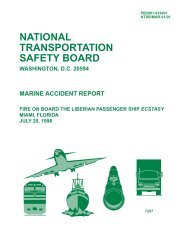Fuel Cells - Green Power - Martin's Marine Engineering Page
Fuel Cells - Green Power - Martin's Marine Engineering Page
Fuel Cells - Green Power - Martin's Marine Engineering Page
- No tags were found...
Create successful ePaper yourself
Turn your PDF publications into a flip-book with our unique Google optimized e-Paper software.
References:Bill McKibben, “A Special Moment inHistory.” The Atlantic Monthly,May, 1998.James J. MacKenzie, “Oil as a FiniteResource: When is GlobalProduction Likely to Peak?”World Resources Institute, March1996.Colin Campbell and Jean H. Laherrère“The End of Cheap Oil .” ScientificAmerican, March 1998.“Busting Through with Ballard.”Financial Times EnergyWorld. Number Five, Winter1998.Jacques Leslie. “The Dawn of theHydrogen Age.” Wired. October,1997.McGraw-Hill Dictionary of Scientificand Technical Terms. 1994.Motor Vehicle Facts and Figures.American AutomobileManufacturers Association. 1998.Resources:World Resources Institutehttp://www.wri.orgInternational <strong>Fuel</strong> <strong>Cells</strong>http://www.hamiltonstandard.com/ifc-onsiUnited Nations Framework Conventionon Climate Changehttp://www.unfccc.de/Linkages http://www.iisd.ca/linkages/Environmental Protection Agency,Alternative <strong>Fuel</strong>shttp:// www.epa.gov/omswwwU.S. <strong>Fuel</strong> Cell Councilhttp://www.usfcc.com<strong>Fuel</strong> <strong>Cells</strong> 2000http://fuelcells.org– CF 2 – CF – CF 2 –lOlCF 2lCF – CF 3lOlCF 2lCF 2lSO 3 - H +Chemical structureof membranematerial;Nafion TM by DuPontDefinitions:Electrochemical reaction: A reactioninvolving the transfer ofelectrons from one chemicalsubstance to another.<strong>Fuel</strong> cell: An electrochemical devicethat continuously converts thechemical energy of externallysupplied fuel and oxidant directlyto electrical energy.Oxidant: A chemical, such as oxygen,that consumes electrons in anelectrochemical reaction.Electrolyte: A substance composed ofpositive and negative ions,Ion: An atom that has acquired anelectrical charge by the loss or gainof electrons.1 micron = 10 -6 m, 10 -4 cm, 10 -3 or0.001 mm = 1 mPolymer: A substance made of giantmolecules formed by the union ofsimple molecules (monomers).Thermal: Pertaining to heatStructure of Polymer Electrolyte MembranesThe polymer electrolyte membrane is a solid, organic polymer,usually poly[perfluorosulfonic] acid. A typical membrane material,such as Nafion TM , consists of three regions:(1) the Teflon-like, fluorocarbon backbone, hundreds of repeating– CF 2 – CF – CF 2 – units in length,(2) the side chains, –O– CF 2 – CF – O– CF 2 – CF 2 –, which connect themolecular backbone to the third region,(3) the ion clusters consisting of sulfonic acid ions, SO 3-The negative ions, SO 3 - , are permanently attached to the side chainand cannot move. However, when the membrane becomes hydratedby absorbing water, the hydrogen ions become mobile. Ion movementoccurs by protons, bonded to water molecules, hopping from SO 3 - siteto SO 3 - site within the membrane. Because of this mechanism, thesolid hydrated electrolyte is an excellent conductor of hydrogen ions.Future OpportunitiesPolymer electrolyte membrane fuel cells arelimited by the temperature range over whichwater is a liquid. The membrane must containwater so that the hydrogen ions can carry thecharge within the membrane. Operating polymerelectrolyte membrane fuel cells attemperatures exceeding 100˚C is possibleunder pressurized conditions, required to keepthe water in a liquid state, but shortens thelife of the cell. Currently, polymer electrolytemembranes cost about $100/square foot.Costs are expected to decrease significantlyas the consumer demand for polymer electrolytemembrane fuel cells increases.Remaining Challenges:H + .• producing membranes not limited by thetemperature range of liquid water,possibly based on another mechanism forprotonic conduction• reducing membrane cost by developingdifferent membrane chemistriesThis document, and more, is available for download at <strong>Martin's</strong> <strong>Marine</strong> <strong>Engineering</strong> <strong>Page</strong> - www.dieselduck.net

















